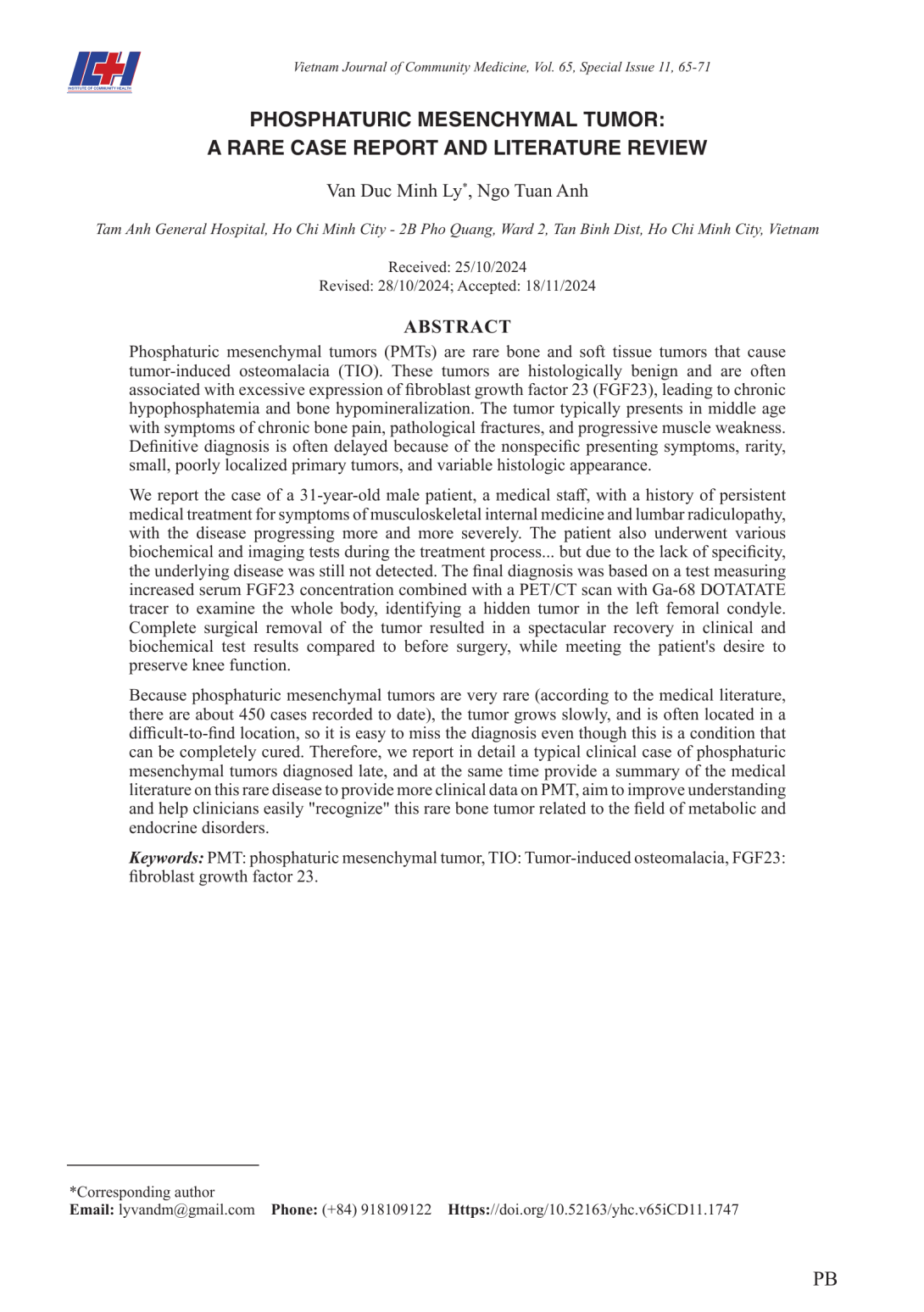
U trung mô phosphaturic (PMT) là một khối u hiếm gặp ở xương và mô mềm gây ra chứng nhuyễn xương do khối u (TIO). Những khối u này về bản chất mô học gần như lành tính và thường liên quan đến tình trạng tăng quá mức yếu tố tăng trưởng nguyên bào sợi 23 (FGF23), dẫn đến tình trạng hạ phosphat máu mãn tính và giảm khoáng hóa xương. Khối u này thường xảy ra ở lứa tuổi trung niên với các triệu chứng đau xương mãn tính, gãy xương bệnh lý và suy nhược cơ tiến triển. Chẩn đoán xác định thường bị trì hoãn do các triệu chứng biểu hiện thường không đặc hiệu, loại bệnh hiếm gặp, khối u cơ bản thường nhỏ khó xác định vị trí và hình ảnh mô học thay đổi. Chúng tôi báo cáo ca bệnh nân nam 31 tuổi, là nhân viên y tế, có bệnh sử điều trị nội khoa dai dẳng các triệu chứng bệnh nội khoa cơ xương khớp và bệnh lý rễ thần kinh cột sống thắt lưng, bệnh tiến triển ngày càng nặng. Bệnh nhân cũng được thực hiện nhiều xét nghiệm sinh hoá, hình ảnh học khác nhau trong tiến trình điều trị… nhưng do chưa đặc hiệu nên vẫn không phát hiện ra bệnh gốc. Cuối cùng chẩn đoán dựa vào xét nghiệm đo nồng độ FGF23 trong huyết thanh tăng cao kết hợp chụp PET/CT với chất đánh dấu Ga-68 DOTATATE khảo sát toàn thân, xác định có khối u ẩn ở vùng lồi cầu xương đùi trái. Phẫu thuật cắt bỏ hoàn toàn khối u mang lại kết quả hồi phục ngoạn mục về lâm sàng và các chỉ số xét nghiệm sinh hoá so với trước mổ, đồng thời đáp ứng được mong muốn bảo tồn chức năng khớp gối cho bệnh nhân. Bởi vì u trung mô phosphaturic rất hiếm gặp (theo y văn đến nay có khoảng 450 ca bệnh được ghi nhận), u phát triển chậm, thường nằm vị trí khó tìm nên dễ bỏ sót chẩn đoán mặc dù đây là tình trạng có thể điều trị khỏi hoàn toàn. Do đó, chúng tôi tiến hành báo cáo chi tiết một trường hợp lâm sàng điển hành u trung mô phosphaturic được chẩn đoán muộn, đồng thời đưa ra tóm tắt tổng quan y văn về bệnh lý hiếm gặp này nhằm cung cấp thêm dữ liệu lâm sàng về PMT, cải thiện sự hiểu biết, giúp các bác sỹ lâm sàng dễ “nhận diện” loại bệnh lý u xương hiếm gặp liên quan lĩnh vực bệnh lý rối loạn chuyển hóa và nội tiết này.
Phosphaturic mesenchymal tumors (PMTs) are rare bone and soft tissue tumors that cause tumor-induced osteomalacia (TIO). These tumors are histologically benign and are often associated with excessive expression of fibroblast growth factor 23 (FGF23), leading to chronic hypophosphatemia and bone hypomineralization. The tumor typically presents in middle age with symptoms of chronic bone pain, pathological fractures, and progressive muscle weakness. Definitive diagnosis is often delayed because of the nonspecific presenting symptoms, rarity, small, poorly localized primary tumors, and variable histologic appearance. We report the case of a 31-year-old male patient, a medical staff, with a history of persistent medical treatment for symptoms of musculoskeletal internal medicine and lumbar radiculopathy, with the disease progressing more and more severely. The patient also underwent various biochemical and imaging tests during the treatment process... but due to the lack of specificity, the underlying disease was still not detected. The final diagnosis was based on a test measuring increased serum FGF23 concentration combined with a PET/CT scan with Ga-68 DOTATATE tracer to examine the whole body, identifying a hidden tumor in the left femoral condyle. Complete surgical removal of the tumor resulted in a spectacular recovery in clinical and biochemical test results compared to before surgery, while meeting the patient's desire to preserve knee function. Because phosphaturic mesenchymal tumors are very rare (according to the medical literature, there are about 450 cases recorded to date), the tumor grows slowly, and is often located in a difficult-to-find location, so it is easy to miss the diagnosis even though this is a condition that can be completely cured. Therefore, we report in detail a typical clinical case of phosphaturic mesenchymal tumors diagnosed late, and at the same time provide a summary of the medical literature on this rare disease to provide more clinical data on PMT, aim to improve understanding and help clinicians easily "recognize" this rare bone tumor related to the field of metabolic and endocrine disorders.
- Đăng nhập để gửi ý kiến
